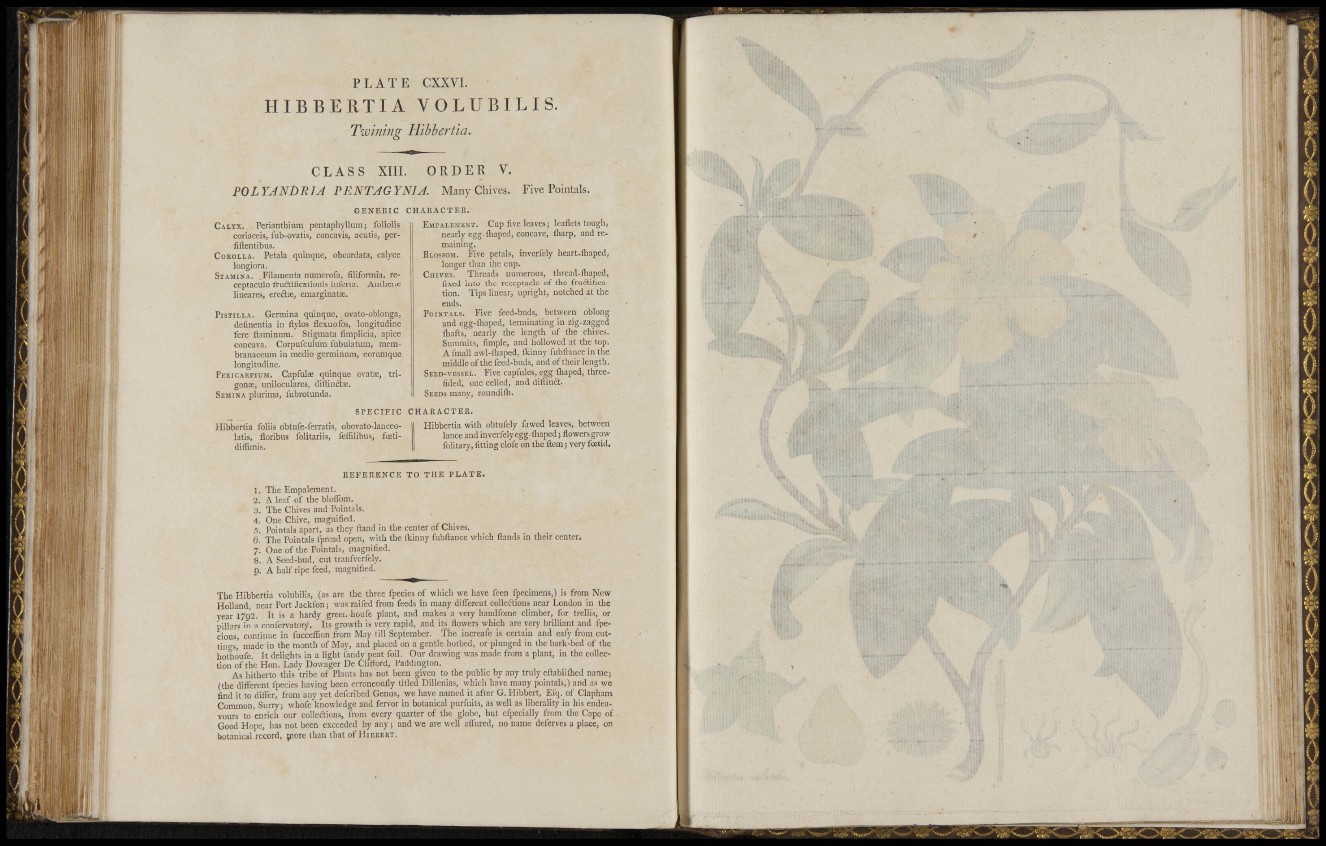
if
v i .
: IL:
J;! R
P L A T E CXXVI.
H I B B E R T I A V O L U B I L Í S.
Tzmning Hibbertia.
CLASS xm. ORDER V.
POLYANDRIA PENTAGONI A. Many Chives. Five Pointals.
CALYX. Perianthlum pentapliyllum; foliolis
coriaceis, lub-ovatis, coiicavis, acutis, perfiltentibus.
COKOLLA. Pétala quinqué, obcordata, calyce
longiora.
STAMINA. . Filamenta numerofa, fillformia, receptáculo
fruaificationis inierta. Anthertie
lineares, ere6tse, emarginata:.
PisTiLLA. Germina quinque, ovato-oblonga,
definentia in ftylos flexuofos, longitudine
fere ftaminura. Stigmata fimplicia, apice
concava. Corpufculum lubulatum, merabranaceunn
in medio germinum, eorumque
longitudine.
PEKICAKPIUM. Capfulae quinque ovatse, trigona,
uniloculares, diftinélae.
SEMINA plurima, lubrotunda.
G E N E R I C CHARACTEE.
EiMrALEMENT. Cup five leaves; leaflets tough,
nearly egg-fliaped, concave, Iliarp, and remaining.
BLOSSOM. Five petals, inverfely heart-lliaped,
longer than the cup.
CHIVES. Threads numerous, thread-iliaped,
fixed into the receptacle of the fruftification.
Tips linear, upright, notched at the
ends.
PoiNTALs. Five feed-buds, between oblong
and egg-fliaped, terminating in zig-zagged
fhafts, nearly the length of the chives.
Summits, fimple, and hollowed at the top.
A Imall awl-fliaped, ikinny fubftauce in the
middle of the feed-buds, and of their length.
SEED-VESSEL. Five capfules, egg fliaped, threefided,
one celled, and diftinft.
SEEDS many, roundifli.
S P E C I F I C
Hibbertia foliis obtufe-ferratis, obovato-lanceolatis,
floribus folitariis, feflilibus, foetidiffimis.
C H A R A C T E E .
Hibbertia with obtufely fawed leaves, between
lance and inverfely egg- fliaped; flowers grow
folitary, fitting clofe on the ftem; very fcetid.
R E F E R E N C E TO THE PLATE.
1. The Empalement.
2. A. leaf of the bloifom.
3. The Chives and Pointals.
4. One Chive, magnified.
5. Pointals apart, as they ftand in the center of Chives.
6. The Pointals fpread open, with the Ikinny fubftance v/hich ftands in their center.
7. One of the Pointals, magnified.
8. A Seed-bud, cut traufverfely.
9. A half ripe feed, magnified.
The Hibbertia volubilis, (as are the three fpecies of which we have feen ijpecimens,) is from New
Holland, near Port Jackfon; was raifed from feeds in many different colleftions near London in the
year 1792. It is a hardy greer. houfe plant, and makes a very handfome climber, for trellis, or
pillars in a confervatory. Its growth is very rapid, and its flowers which are very brilliant and fpecious,
continue in fucceffion from May till September. The increafe is certain and eafy from cuttino
s,' made in the month of May, and placed on a gentle hotbed, or plunged in the bark-bed of the
hothoufe. It delights in a light fandy peat foil. Our drawing was made from a plant, in the collection
of the Hon. Lady Dowager De Cliftbrd, Paddington.
As hitherto this tribe of Plants has not been given to the public by any truly eftabliihed name;
(the different fpecies having been erroneoufly titled Dillenias, which have many pointals,) and as we
find it to differ, from any yet defcribed Genus, we have named it after G. Hibbert, Efq. of Clapham
Common, Surry; whofe knowledge and fervor in botanical purfuits, as well as liberality in his endeavours
to enrich our colleaions, from every quarter of the globe, but efpecially from the Cape of
Good Hope, has not been exceeded by any; and we are well affured, no name deferves a place, on
botanical record, pnore than that of HIBBERT.
•ji-i
•r A .
1 1 1 m
" i ' l
Mi' - ; t ' i
e ; • :l :l
1 ri'.
teS^^iilir